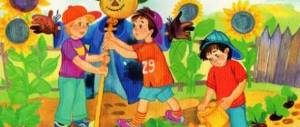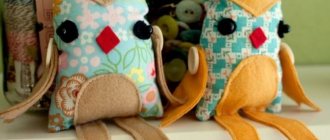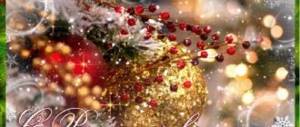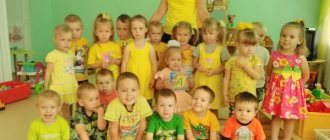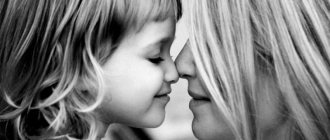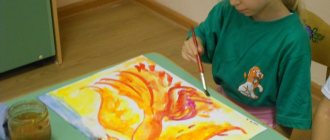Preparatory group. Senior preschool age. Children 6-7 years old
Project “Ural. Bazhov P. P.” in the preparatory group Organization: MBDOU Kindergarten No. 12 . G. Urai. Author of the project : teacher Marina Arkadyevna Shapkina. Project type : creative, information and research. Project participants : children of the preparatory school group, teachers, parents. Goal: To introduce children to creativity...
Project “Non-traditional drawing techniques” for children 5–6 years old Project : “Non-traditional drawing techniques as a means of developing the creative abilities of children of senior preschool age” Project : teacher Lukyanova O.S. Project participants : children of the 2nd senior group, teachers, parents of pupils Target group:…
PROJECT IN THE PREPARATION GROUP “SAFETY WEEK”
Municipal budgetary preschool educational institution "Kindergarten No. 61 "Flag" of the city of Smolensk
PROJECT
IN THE PREPARATION GROUP “SAFETY WEEK”
Educator: Gerasimova I.S.
Project passport
Project topic:
"Safety Week".
Project implementation period
: 1 Week.
Project type
: short term.
Author of the project:
teacher – Gerasimova Irina Stefanovna
Project participants
: teachers, children and their parents.
Relevance of the project
During the period of preschool childhood, there is an intensive exploration of the world as an interconnected and interdependent world of nature, society and man, so the topic of the project is more relevant than ever.
At this age, there is a process of learning the values and meanings of life, forming the foundations of safe behavior.
The main task of forming the foundations of safety is the development of independence and responsibility in children, since safety is not just the sum of acquired knowledge, but a lifestyle, correct behavior in various situations.
Objective of the project:
to form conscious behavior that allows you to avoid dangerous situations at home. To consolidate knowledge about safety rules when dealing with household appliances and sharp objects, to promote caution when communicating with strangers.
Tasks:
to form in preschoolers an idea of objects and situations that are dangerous to life and health that occur in everyday life;
teach to follow certain rules of behavior at home;
stimulate the development of independence and responsibility in preschoolers;
develop attention, memory, instinct of self-preservation.
Planned result
: children of senior preschool age who know and follow the rules of safe behavior at home, who are aware of careful handling of dangerous objects and correct behavior when contacting strangers.
Integration of educational areas:
social and communicative development, cognitive development, speech development, artistic and aesthetic development, physical development.
Main forms of project implementation:
situational conversations, direct educational activities, children's artistic creativity, didactic games, outdoor games, reading fiction, working with parents.
Project stages:
Stage I
–
preparatory :
determining the goals and objectives of the project, studying methodological literature, assessing the level of children’s knowledge on the topic, drawing up an action plan for organizing children’s activities.
Stage II
–
main:
(project implementation): planned activities are carried out for the implementation of the project (conversations, classes, didactic games, outdoor games, viewing, reading fiction, role-playing games, productive activities, analysis of problematic
Project in the preparatory school group “Winter-winter!”
Soldatenkova Yu.A. Project in the preparatory school group “Winter-winter!” // Owl. 2020. N3 (21). URL: https://kssovushka.ru/zhurnal/21/ (date of access: 10.10.2020).
Order No. 699953
Project passport
Project type: educational and creative.
Duration: medium term.
Participants: children of the preparatory group, parents, teachers.
Relevance: teach children to see the beauty of the world around them and improve the technical aspects of visual arts. Concretize children's idea of winter as a time of year.
Goal: to provide knowledge about living and inanimate nature in winter. To cultivate a love for the nature of one’s native land and a caring attitude towards it. Creating conditions for the development of children’s cognitive and creative abilities in the process of developing the joint project “Winter-Winter!”
Project objectives:
- Expand your understanding of winter natural phenomena through cognitive activities.
- Introduce the phenomena of inanimate nature (frost, strong winds, it is snowing, blizzards are blowing, frozen water bodies), the properties of snow (white, crispy, crumbly, cold, fluffy, sticky).
- Clarify and expand on the lifestyle of wild animals in winter (hare, fox, wolf, bear and squirrel). Expand your understanding of the diversity of birds (bullfinches, tits, sparrows), methods of obtaining food, and adaptation to winter living conditions.
- Learn to establish connections between living and inanimate nature (weather - state of water, snow; season - state of plants), analyze, draw conclusions.
- To develop curiosity, cognitive interests, attention, memory, speech, observation, desire to care for animals and plants, and environmental awareness of preschoolers.
- Evoke more positive emotions, feelings of admiration for nature.
- Develop communication skills, memory, attention, creativity.
Tasks for children:
- Expand children's understanding of the characteristic features of winter.
- Develop the ability to reflect the signs of winter in your works using different materials.
- To promote the development of general speech skills, intonation expressiveness, fine motor skills of the fingers, and expansion of vocabulary.
- Foster love and respect for nature.
Tasks for parents:
- Create favorable conditions in the family for the development of the child’s personality.
- Take into account the children’s experience acquired in kindergarten.
Task for the teacher:
- Develop professional competence and personal potential.
Expected results for the project:
- children gain experience of productive interaction with each other
- increased cognitive activity;
- mastering the necessary knowledge on the topic “Winter”;
- the formation of a sustainable interest in observing natural phenomena.
Project implementation forms:
- Conversations
- Observations
- Leisure activities
- Play activity
- Productive activities of children
- Reading fiction
Project implementation stages:
The first stage is preparatory:
- Creating the necessary conditions for the implementation of the project.
- Development and accumulation of teaching materials.
- Creation of a developmental environment.
- Selection of fiction on the topic.
- Development of events.
The second stage is the main (practical):
- Conducting conversations
- Reading fiction
- Word games
- Didactic games
- Examination of posters on the rules of safe behavior in winter
- Artistic work
- Outdoor games, round dance games.
- Working with a parent
- Design of a travel folder for parents “Walks in winter”, “Winter injuries”, “Ice”.
- Help in decorating the group for the New Year.
- Exhibition of family creative works “New Year’s Toy”
The third stage is final:
- Processing of project implementation results
- Exhibition of children's works "Winter-Winter"
- New Year's party "12 months"
Plan of work with children for the implementation of the project “Winter-Winter!”
| Educational areas | Forms of working with children |
| Cognitive development | Familiarization With to those around peace: Conversations "Why I like winter" "Winter Fun" “How animals spend the winter in the forest” “How a person helps birds and animals in winter” "Beware of winter injuries" Design and Manual Labor: “Snowman”, “Christmas trees”, “Cockerel” Observation cycle : — changes in winter nature during walks (sun, sky, wind force, snow) -for the beauty and richness of winter colors - for the birds — behind the trees growing on the territory of the kindergarten |
| Artistic and aesthetic development | Decorative drawing: "Frost patterns" Plasticineography: "Winter in the Forest" Reading fiction : M. Prishvin “Floors of the Forest” V. Bianchi “Forest in winter”, “A simple letter and a letter with cunning” G. Skrebitsky “In a forest clearing” V. Arkhangelsky “Fluffy snowflakes are flying” E. Uspensky “The Mischief of the Old Woman of Winter” N. Nosov “On the Hill” Russian folk tales: “Winter quarters of animals”, “The boasting hare”, “Two frosts”. Literary fairy tales: “Morozko”, “Twelve Months”, “Moroz Ivanovich”, “Snow Maiden”. Foreign fairy tales: “The Snow Queen”, “The Nutcracker”. Riddles on the theme “Winter” Music Listening to music: “Seasons” by P.I. Tchaikovsky, “Waltz of Snow Flakes” from the ballet “The Nutcracker” by P.I. Tchaikovsky. Singing: "What we like in winter" “Blizzard” by G. Sviridov New Year's round dances, singing New Year's songs Holiday New Year's party "12 months" |
| Speech development | Creative storytelling children By topics: • “Signs of winter”, • “Who needs winter”, • “If there was no snow in winter...”. • Looking at pictures about winter and writing descriptive stories based on them Word games: “Which one, which one, which one?”, “How to say it differently?”, “Say it the other way around.” |
| Social and communicative development | Didactic games: “Seasons”, “Find out by description”, “Winter supplies”, “Find and feed wintering birds”, “When this happens”, “What comes first, what comes later”. Board and printed games: “Seasons” Labor activity: Preparing bird food, feeding birds. Clearing paths of snow while walking. Buildings made of snow. Conversations on life safety: Conversation: “The frost has come - take care of your ears and nose”, “If you want to be healthy - harden yourself”, “Caution, ice”, “First aid for frostbite”, “What to do to avoid freezing” Examination of posters on the rules of safe behavior in winter. |
| Physical development | Movable games: “Two Frosts”, “Frost, Red Nose”, “Little White Bunny Sitting”, “Homeless Hare”, “Snowballs”. Winter fun: “Snipers”, “Who is further”, “Snow carousel”, “Who is faster” Folk games: "Snow Woman", "Frost" |
Results of project activities:
- Children have an idea about winter, its signs, and have acquired new cognitive experiences;
- Familiar with the works of poets, writers and on the theme of winter;
- Possess an expanded vocabulary;
- Have an idea about the nature of their native land;
- Familiar with the rules of safe behavior in nature;
- Exhibition of creative works of children;
- Exhibition of family works “New Year’s Toy”;
- Recommendations for parents have been developed;
- Increasing the percentage of parents showing interest in the life of the kindergarten.
Conclusions: Each child participated in the project with desire, showing initiative. Children began to say: “you need to help the birds in the cold season,” “you need to be careful on the skating rink, on the slide,” “winter is a very fun time of year!” What the children liked most about the project was the productive and research activities. At the end of the project, children can independently establish the dependence of the life of plants and animals on changes in nature. Children's knowledge about nature in winter has expanded. Parent-child relationships have strengthened. Parents began to take a more active part in the life of the kindergarten. Everyone took part in the New Year's party with pleasure.
Literature:
- Veraksa N.E., Komarova T.S., Vasilyeva M.A. From birth to school: program. M.: Mozaika-Sintez, 2011.
- Kulikovskaya T.A. Funny sayings. M.: Gnome-Press, 1999.
- Nikitina A.B. Theater where children play. M.: Vlados, 2001.
- Magazine "Preschool Education". 2012. No. 3, 7, 10.
- Lykova I.A. Colored palms: program. M.: Sphere.
Cognitive and research project in the preparatory group of a preschool educational institution
Cognitive and research project “Sorceress-Salt” with children of the preparatory group.
Goal:
developing an idea of salt as a necessary product for humans through observation and experimentation.
Objectives:
Find out whether it is possible to do without salt?
What is it for? Investigate the properties of salt experimentally. Conduct experiments on growing salt crystals. Project defense:
After reading the fairy tale “Gold and Salt” to the children, the children had a question: “Where does salt come from?”
The children began to argue that we eat salt every day, and it comes in different forms: coarse, fine, sea, colored, rock, table salt. One of the guys said that salt is mined on land and water. The children were very interested in this and we decided to explore salt and learn everything about it. A little history: Salt appeared in human life in ancient times. How exactly people learned that food seasoned with white grains tastes better and lasts longer is no longer known. But as soon as people learned the taste of salt, they began to value it extremely. The area, rich in its deposits, was quickly populated and became the property of a tribe. Salt is found in common foods such as cottage cheese, cheese, bread, cookies or cornflakes. There is enough salt in dairy products, vegetables and meat for a person not to lack it. Salt is found in vegetables and some fruits. Salt is an important seasoning, without which food is bland. Vegetables are prepared with it for the winter (cucumbers, tomatoes, cabbage are pickled). Salt is also a symbol of hospitality and friendship. “Sharing bread and salt” meant maintaining a long-term relationship. Hence the popular sign - spilling salt means quarrel, failure. Salt has always been treated with respect and sparingly. There are also many sayings associated with salt. We learned some of them: Under-salting on the table, over-salting on the back. Without bread you are not full, and without salt you are not sweet. Salt was brought to Kievan Rus from salt lakes on the Black and Azov Seas. Here it was bought and taken to the North. Salt was so expensive that at ceremonial feasts it was served on the tables of noble guests, while others dispersed “without salt.” After talking with my mother, we learned some tricks related to salt. For example, to prevent hot vegetable oil from splashing in different directions in a frying pan, you need to sprinkle the hot oil with salt. To easily peel boiled chicken eggs, add a little salt to the water in which they will be boiled. How to determine the freshness of a chicken egg? Add a teaspoon of salt to a cup of water. Place an egg into the solution. If it floats up, it’s better not to use it, but if it drowns in such water, it’s most likely fresh. Adding a pinch of salt to a jug of fresh milk will help it last longer. We developed and discussed a detailed plan for studying salt. We set ourselves goals and objectives: to study the properties of salt, grow salt crystals, study and compare salt and fresh water. We recorded all our observations and experiences in an observation diary. This is how much interesting we learned about salt. But she really is magical. No wonder people say: if there is no salt, there is no word! Diary of observations and experiments in the project “Salt is a magician”. How did our research begin? First we studied the properties and qualities of salt. We found out that the salt tastes salty, is white, odorless, and free-flowing. 1. Salt dissolves in water. We took a container with water, immersed a spoon with salt in it - the salt disappeared from it. Conclusion: salt dissolves in water.
2.Salt in water of different temperatures. We took two glasses of cold and hot water. And they put one heaped tablespoon of salt in each of them. The water in the glasses became cloudy. But in a glass of hot water, the salt dissolved faster, and the water was almost clear. And in a glass of cold water, the salt fell to the bottom, but the water itself remained cloudy for a long time. Conclusion: salt dissolves faster in hot water.
3.Floating egg. Let's conduct an experiment and check how salt water will push objects to the surface! To conduct the experiment we will need: 2 raw eggs, 2 glass containers with water, several tablespoons of salt. Place one raw egg in a container with clean tap water. What happened to him? The egg sank to the bottom. Dissolve the salt in a second vessel with water and lower the egg into the salt water. The egg was left floating on the surface of the water! Conclusion: Salt really does push things out of water. The more salt there is in the water, the more difficult it is to drown in it.
4. Obtaining crystals. We took a small saucer, poured water into it, added salt, stirred it and left it on the radiator overnight. In the morning, the water in the saucer evaporated, leaving large salt crystals at the bottom. We learned that when salt water evaporates, crystals form. 5.Salt is a cleaning agent. We took a dirty glass, poured a little salt on a sponge and washed the glass. It became clean, even shiny. Conclusion: You can use salt to wash dishes.
It was very interesting for us to work on this topic. We asked our parents what they know about the beneficial properties of salt for people’s lives. It turns out that parents know a lot and they were happy to share their knowledge with us. And we talked about what we had learned ourselves when we carried out observations and experiments, and read the encyclopedia. We also became convinced that the simplest and most familiar things can be unusual. After finishing the project, we learned: Salt is a white crystalline substance with a pungent, salty taste. It dissolves well in water. Salt is a mineral that is used by humans in everyday life and in production. Salt is a helper in the household. Salt is a food and seasoning, a preservative. Salt is essential for human life and health. When salt water evaporates, white crystals appear that taste salty.
We recommend watching:
Project in a kindergarten for older preschoolers 5-7 years old on legal topics Project in the senior group of a kindergarten Project in a senior group on the topic “Trees and shrubs in spring” Practice-oriented project for landscaping the territory of a kindergarten
Similar articles:
Educational and creative project on the theme “Golden Autumn”. Junior group
Project for children of the senior group “Our cheerful garden”
